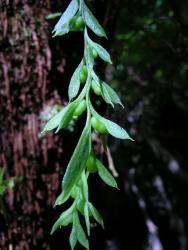Epiphytic or occasionally terrestrial ferns. Rhizomes dichotomously branched, subterranean, bearing brown rhizoidal hairs. Aerial stems pendulous, unbranched or dichotomously branched, flattened, glabrous, either growing indeterminately or terminated by a large leaf. Sterile leaves scale-like proximally, expanded and flattened distally, spirally arranged or distichous, 1-veined, bases unequally cuneate. Synangia bilobed, equal or unequal, arranged on the adaxial margin of bifid sporophylls; lobes conic or round- ended. Spores monolete, ellipsoidal, rugulate to smooth.
A genus of about 15 species. Allan (1961) and authors of earlier New Zealand Flora treatments all recognised only a single species of Tmesipteris. Nineteenth century authors all misidentified this as T. forsteri Endl., an illegitimate name for the species now known as T. norfolkensis - a plant endemic to Norfolk Island. Later authors referred the New Zealand species to T. tannensis. However, the genus was critically revised by Chinnock (1975) who identified four species, including T. sigmatifolia which was described for the first time. A fifth species, T. horomaka, was described more recently by Perrie et al. (2010) and is so far known only from Banks Peninsula. Unlike the other New Zealand species, which are all tetraploid (Brownsey & Lovis 1987), T. horomaka is octoploid and possibly an allopolyploid derivative of T. tannensis and T. elongata. In addition, two further species may be present in New Zealand. Plants resembling T. obliqua from south-east Australia occur in the far south of the South Island, and others similar to T. norfolkensis are known from Northland and Great Barrier Island. Further work is needed to determine the true identity of these plants.
A clearer understanding of the diversity within Tmesipteris has only emerged since the 1970s, with species descriptions now available for the Philippines (Gruèzo 2012), Australia (Chinnock 1998), the Solomon Islands (Braithwaite 1973), Vanuatu (Braithwaite 1986), New Caledonia (Brownlie 1969), Fiji (Brownlie 1977a) and French Polynesia (Murdock & Smith 2003).
| 1 | Sterile leaves distichously arranged | 2 |
| Sterile leaves spirally arranged | 3 | |
| 2 | Sterile leaves ovate to elliptic, shiny green; sporophylls usually in lower half of stem; stems undivided | lanceolata |
| Sterile leaves narrowly ovate to narrowly oblong, dull green; sporophylls usually in middle or upper part of stem; stems undivided or branched one to several times | elongata | |
| 3 | Synangia with pointed ends | 4 |
| Synangia with rounded ends | 5 | |
| 4 | Synangial lobes usually separated from subtending sporophyll, pointing upwards | tannensis |
| Syngangial lobes appressed to subtending sporophyll, pointing laterally or downwards | horomaka | |
| 5 | Stems undivided; sterile leaves often slightly sigma-shaped; mucro 1.5–3.5 mm long; synangial lobes often unequal in size | sigmatifolia |
| Stems undivided or branched one to several times; sterile leaves straight or falcate; mucro 1–2.5 mm; synangial lobes equal in size | 6 | |
| 6 | Sterile leaves usually emarginate to truncate, up to 25 mm long | horomaka |
| Sterile leaves usually cuspidate to acuminate, up to 45 mm long | elongata |
One species in the Philippines, at least one in Papua New Guinea, seven in Australia (including Lord Howe and Norfolk Islands), three in the Solomon Islands, four in New Caledonia, three in Vanuatu and one each in Fiji, Samoa, Society Islands and the Marquesas. Five species in New Zealand; two endemic.
| Category | Number |
|---|---|
| Indigenous (Endemic) | 2 |
| Indigenous (Non-endemic) | 3 |
| Total | 5 |
Tetraploid counts of n = 104 have been reported from New Zealand (Brownsey & Lovis 1987), Australia (Barber 1957) and Vanuatu (Braithwaite 1986), and octoploid counts of n = 208 from New Zealand (Perrie et al. 2010), Australia (Barber 1957) and Vanuatu (Braithwaite 1986).
The gametophytes of Tmesipteris species are unusual amongst ferns in being buried (usually in tree fern trunks, but sometimes underground), non-green, mycorrhizal, cylindrical and frequently branched (Holloway 1918, 1921). They are similar to those of Psilotum in this regard.




